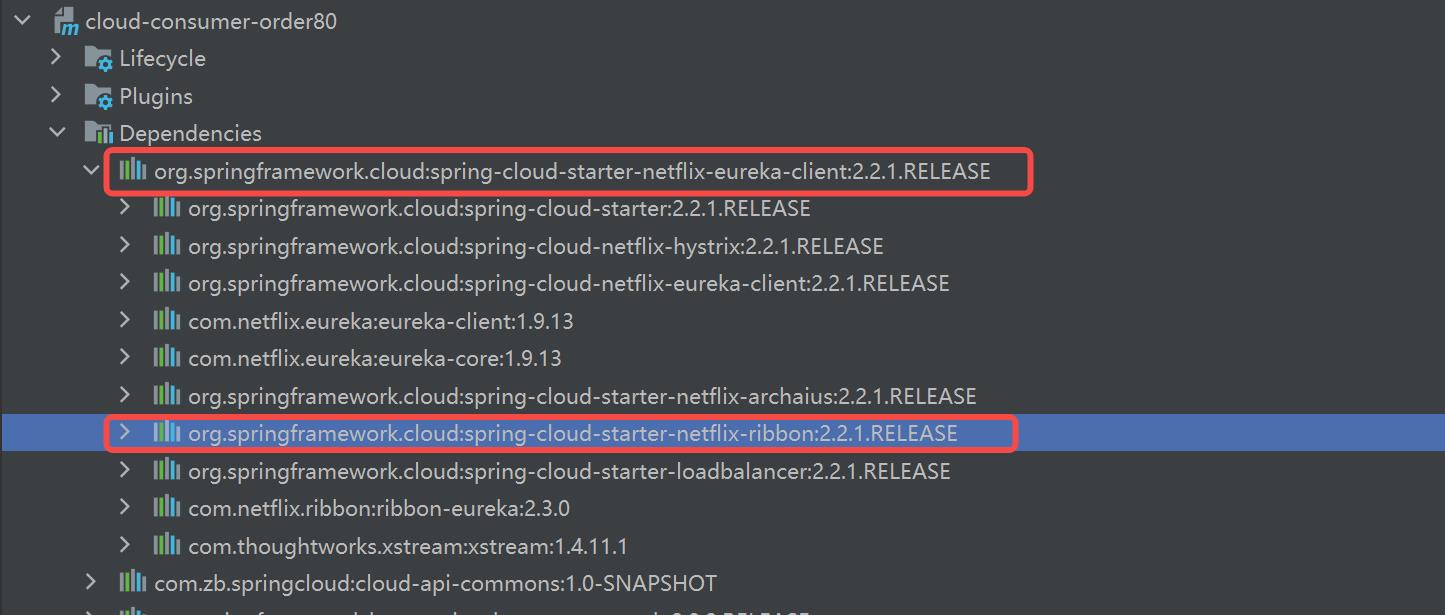Spring Cloud系列之 RibbonOpenFeign
Posted AC_Jobim
tags:
篇首语:本文由小常识网(cha138.com)小编为大家整理,主要介绍了Spring Cloud系列之 RibbonOpenFeign相关的知识,希望对你有一定的参考价值。
Spring Cloud系列(二)之 Ribbon、OpenFeign
使用SpringCloud版本:
2.1.1.RELEASE
一、Ribbon负载均衡服务调用
-
Ribbon是Netflix发布的负载均衡器,有助于控制HTTP客户端行为。为Ribbon配置服务提供者地址列表后,Ribbon就可基于负载均衡算法,自动帮助服务消费者请求。
-
Ribbon默认提供的负载均衡算法:轮询,随机其他…。当然,我们可用自己定义负载均衡算法

Ribbon 与 Nginx 区别?
-
服务器端负载均衡 Nginx
nginx 是客户端所有请求统一交给 nginx,由 nginx 进行实现负载均衡请求转发,属于服务器端负载均衡。即请求由 nginx 服务器端进行转发。
-
客户端负载均衡 Ribbon
Ribbon 是从 eureka 注册中心服务器端上获取服务注册信息列表,缓存到本地,然后在本地实现轮询负载均衡策略。即在客户端实现负载均衡。
1.1 Ribbon负载均衡实现过程
RestTemplate的使用:
-
GET请求方法
<T> T getForObject(String url, Class<T> responseType, Object... uriVariables); <T> T getForObject(String url, Class<T> responseType, Map<String, ?> uriVariables); <T> T getForObject(URI url, Class<T> responseType); <T> ResponseEntity<T> getForEntity(String url, Class<T> responseType, Object... uriVariables); <T> ResponseEntity<T> getForEntity(String url, Class<T> responseType, Map<String, ?> uriVariables); <T> ResponseEntity<T> getForEntity(URI var1, Class<T> responseType);-
getForObject方法:
返回对象为响应体中数据转化成的对象。
@GetMapping("/consumer/payment/get/id") public CommonResult<Payment> getPayment(@PathVariable("id") Long id) return restTemplate.getForObject(PAYMENT_URL+"/payment/get/"+id,CommonResult.class); -
getForEntity方法
返回对象为ResponseEntity对象,包含了响应中的一些重要信息,比如响应头、响应状态码、响应体等,举例如下:
@GetMapping("/consumer/payment/getFroEntity/id") public CommonResult<Payment> getPayment2(@PathVariable("id") Long id) ResponseEntity<CommonResult> entity = restTemplate.getForEntity(PAYMENT_URL + "/payment/get/" + id, CommonResult.class); if(entity.getStatusCode().is2xxSuccessful()) return entity.getBody(); else return new CommonResult<>(444,"操作失败");
-
-
POST请求方法
<T> T postForObject(String url, @Nullable Object request, Class<T> responseType, Object... uriVariables); <T> T postForObject(String url, @Nullable Object request, Class<T> responseType, Map<String, ?> uriVariables); <T> T postForObject(URI url, @Nullable Object request, Class<T> responseType); <T> ResponseEntity<T> postForEntity(String url, @Nullable Object request, Class<T> responseType, Object... uriVariables); <T> ResponseEntity<T> postForEntity(String url, @Nullable Object request, Class<T> responseType, Map<String, ?> uriVariables); <T> ResponseEntity<T> postForEntity(URI url, @Nullable Object request, Class<T> responseType);代码示例:
@PostMapping("/insert") public Result insert(@RequestBody User user) return restTemplate.postForObject(userServiceUrl + "/user/insert", user, Result.class);
实现过程:
-
导入依赖
<dependency> <groupId>org.springframework.cloud</groupId> <artifactId>spring-cloud-starter-netflix-ribbon</artifactId> </dependency>注意eureka的客户端中包含ribbon依赖,所以如果导入了eureka依赖就不用再导入ribbon依赖了。

-
在Eureka中注册服务提供者集群(8001、8002)

-
编写服务提供者的Controller方法
@GetMapping(value = "/payment/get/id") public CommonResult<Payment> getPaymentById(@PathVariable("id") Long id) Payment payment = paymentService.getPaymentById(id); log.info("*****查询结果:",payment); int w = 5/2; if (payment != null) return new CommonResult(200,"查询成功"+", 服务端口:"+serverPort,payment); else return new CommonResult(444,"没有对应记录,查询ID: "+id,null); -
在服务消费者配置类中给RestTemplate这个Bean添加一个
@LoadBalanced注解,用来实现负载均衡功@Configuration public class ApplicationContextConfig @Bean @LoadBalanced //使用@LoadBalanced注解赋予RestTemplate负载均衡的能力 public RestTemplate getRestTemplate() return new RestTemplate(); -
编写服务消费者中的Controller中的方法。不再手动获取ip和端口,而是直接通过服务名称调用
@Resource private RestTemplate restTemplate; public static final String PAYMENT_URL = "http://CLOUD-PAYMENT-SERVICE"; @GetMapping("/consumer/payment/get/id") public CommonResult<Payment> getPayment(@PathVariable("id") Long id) return restTemplate.getForObject(PAYMENT_URL+"/payment/get/"+id,CommonResult.class); -
访问测试,spring会自动帮助我们从eureka-server端,根据服务名称,获取实例列表,而后完成负载均衡

1.2 Ribbon的负载均衡策略
所谓的负载均衡策略,就是当A服务调用B服务时,此时B服务有多个实例,这时A服务以何种方式来选择调用的B实例,ribbon可以选择以下几种负载均衡策略。
| 内置负载均衡规则类 | 规则描述 |
|---|---|
| RoundRobinRule | 简单轮询服务列表来选择服务器。它是Ribbon默认的负载均衡规则。 |
| AvailabilityFilteringRule | 先过滤掉故障实例,再选择并发较小的实例 |
| WeightedResponseTimeRule | 对RoundRobinRule的扩展,响应速度越快的实例选择权重越大,越容易被选择 |
| ZoneAvoidanceRule | 采用双重过滤,同时过滤不是同一区域的实例和故障实例,选择并发较小的实例。 |
| BestAvailableRule | 会先过滤掉由于多次访问故障而处于断路器跳闸状态的服务,然后选择一个并发量最小的服务 |
| RandomRule | 随机选择一个可用的服务器 |
| RetryRule | 先按照RoundRobinRule的策略获取服务,如果获取服务失败则在指定时间内会进行重试,获取可用的服务 |
继承关系:

修改Ribbon负载均衡策略(修改成随机选择):
注意:官方文档明确给出了警告
这个自定义配置类不能放在@ComponentScan所扫描的当前包下以及子包下,否则我们自定义的这个配置类就会被所有的Ribbon客户端所共享,达不到特殊化定制的目的了。
-
在@ComponentScan所扫描不到的包中新建配置类
MySelfRule
@Configuration public class MySelfRule @Bean public IRule myRule() return new RandomRule();//定义为随机 -
在主启动类添加@RibbonClient注解
@SpringBootApplication @EnableEurekaClient // 用来指定CLOUD-PAYMENT-SERVICE服务采用MySelfRule配置类中配置的负载均衡策略 @RibbonClient(name = "CLOUD-PAYMENT-SERVICE",configuration= MySelfRule.class) public class OrderMain80 public static void main(String[] args) SpringApplication.run(OrderMain80.class, args); -
测试可以发现restTemplate将使用随机调用(注意使用restTemplate调用时服务名称改成大写,否则不起作用)
1.3 负载均衡算法原理分析
负载均衡算法:rest接口第几次请求数 % 服务器集群总数量 = 实际调用服务器位置下标 ,每次服务重启动后rest接口计数从1开始。
List<ServiceInstance> instances = discoveryClient.getInstances("CLOUD-PAYMENT-SERVICE");
如: List [0] instances = 127.0.0.1:8002
List [1] instances = 127.0.0.1:8001
8001 + 8002 组合成为集群,它们共计2台机器,集群总数为2, 按照轮询算法原理:
当总请求数为1时: 1 % 2 =1 对应下标位置为1 ,则获得服务地址为127.0.0.1:8001
当总请求数位2时: 2 % 2 =0 对应下标位置为0 ,则获得服务地址为127.0.0.1:8002
当总请求数位3时: 3 % 2 =1 对应下标位置为1 ,则获得服务地址为127.0.0.1:8001
当总请求数位4时: 4 % 2 =0 对应下标位置为0 ,则获得服务地址为127.0.0.1:8002
RoundRobinRule源码:
public class RoundRobinRule extends AbstractLoadBalancerRule
private AtomicInteger nextServerCyclicCounter;
private static final boolean AVAILABLE_ONLY_SERVERS = true;
private static final boolean ALL_SERVERS = false;
private static Logger log = LoggerFactory.getLogger(RoundRobinRule.class);
public RoundRobinRule()
this.nextServerCyclicCounter = new AtomicInteger(0);
public RoundRobinRule(ILoadBalancer lb)
this();
this.setLoadBalancer(lb);
public Server choose(ILoadBalancer lb, Object key)
if (lb == null)
log.warn("no load balancer");
return null;
else
Server server = null;
int count = 0;
while(true)
if (server == null && count++ < 10)
List<Server> reachableServers = lb.getReachableServers();//得到可以连接的server
List<Server> allServers = lb.getAllServers();//得到所有的server 并且放在list中了。
int upCount = reachableServers.size();//在注册中心连接的。得到数量
int serverCount = allServers.size();// 所有server的数量
if (upCount != 0 && serverCount != 0)
int nextServerIndex = this.incrementAndGetModulo(serverCount);//关键在于这个方法的的next值。得到list集合中要访问服务器的下标
server = (Server)allServers.get(nextServerIndex);
if (server == null)
Thread.yield();
else
if (server.isAlive() && server.isReadyToServe())
return server;
server = null;
continue;
log.warn("No up servers available from load balancer: " + lb);
return null;
if (count >= 10)
log.warn("No available alive servers after 10 tries from load balancer: " + lb);
return server;
// 通过CAS保证线程安全
private int incrementAndGetModulo(int modulo)
int current;
int next;
do
current = this.nextServerCyclicCounter.get();//这个是我们的atmic原子类。得到默认的值0
next = (current + 1) % modulo;//这个是服务的个数。这个next的值如果这一样取,其实就是和serverlist的下标对应,并且,每次加1.
while(!this.nextServerCyclicCounter.compareAndSet(current, next));//因为是多线程,我们要保证安全,所以一用了循环的CAS
return next;
public Server choose(Object key)
return this.choose(this.getLoadBalancer(), key);
public void initWithNiwsConfig(IClientConfig clientConfig)
二、OpenFeign服务接口调用
-
在认识 Feign 之前,微服务之间调用。我们使用的是
Ribbon + RestTemplate方式 -
Feign是声明式的服务调用工具,我们只需创建一个接口并用注解的方式来配置它,就可以实现对某个服务接口的调用,简化了直接使用RestTemplate来调用服务接口的开发量。Feign具备可插拔的注解支持,同时支持Feign注解、JAX-RS注解及SpringMvc注解。当使用Feign时,Spring Cloud集成了Ribbon和Eureka以提供负载均衡的服务调用及基于Hystrix的服务容错保护功能。
2.1 OpenFeign使用步骤
项目架构:

-
新建一个
cloud-consumer-feign-order80模块 -
导入依赖
<!--openfeign--> <dependency> <groupId>org.springframework.cloud</groupId> <artifactId>spring-cloud-starter-openfeign</artifactId> </dependency> <!--eureka client--> <dependency> <groupId>org.springframework.cloud</groupId> <artifactId>spring-cloud-starter-netflix-eureka-client</artifactId> </dependency> <!-- 引入自己定义的api通用包,可以使用Payment支付Entity --> <dependency> <groupId>com.zb.springcloud</groupId> <artifactId>cloud-api-commons</artifactId> <version>1.0-SNAPSHOT</version> </dependency> <!--web--> <dependency> <groupId>org.springframework.boot</groupId> <artifactId>spring-boot-starter-web</artifactId> </dependency> -
编写application.yml文件
server: port: 80 eureka: client: # 表示是否将自己注册进EurekaServer默认为true。 register-with-eureka: false service-url: defaultZone: http://eureka7001.com:7001/eureka/ -
启动类上添加
@EnableFeignClients注解来启用Feign的客户端功能@SpringBootApplication @EnableFeignClients // 激活并开启Feign public class OrderFeignMain80 public static void main(String[] args) SpringApplication.run(OrderFeignMain80.class, args); -
添加Service接口完成对服务提供者接口绑定
我们通过@FeignClient注解实现了一个Feign客户端,其中的value指定服务提供方服务名称
@Component @FeignClient(value = "CLOUD-PAYMENT-SERVICE") //添加@FeignClient注解,指定服务提供方服务名称 public interface PaymentFeignService @GetMapping(value = "/payment/get/id") CommonResult<Payment> getPaymentById(@PathVariable("id") Long id); @GetMapping(value = "/payment/feign/timeout") String paymentFeignTimeOut(); -
添加Controller调用Service实现服务调用
@RestController @Slf4j public class OrderFeignController @Autowired private PaymentFeignService paymentFeignService; @GetMapping(value = "/consumer/payment/get/id") public CommonResult<Payment> getPaymentById(@PathVariable("id") Long id) return paymentFeignService.getPaymentById(id)以上是关于Spring Cloud系列之 RibbonOpenFeign的主要内容,如果未能解决你的问题,请参考以下文章